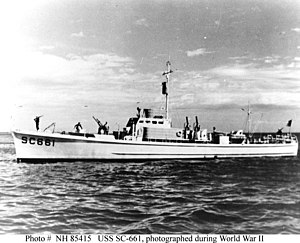
USS Admirable (AM-136) was the lead ship of her class of minesweeper built for the United States Navy during World War II. In commission from 1943 to 1945, she was transferred to the Soviet Navy in 1945 and served as T-331 until stricken in 1958.

A submarine chaser or subchaser is a small naval vessel that is specifically intended for anti-submarine warfare. Many of the American submarine chasers used in World War I found their way to Allied nations by way of Lend-Lease in World War II.
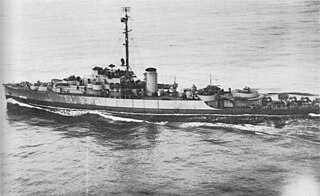
USS Gloucester (PF-22), a Tacoma-class frigate in commission from 1943 to 1945, was the second ship of the United States Navy to be named for Gloucester, Massachusetts. She later served in the Soviet Navy as EK-26 and in the Japan Maritime Self-Defense Force as JDS Tsuge (PF-12) and JDS Tsuge (PF-292).

USS Sandusky (PF-54), a Tacoma-class frigate in commission from 1944 to 1945, was the second United States Navy ship of the name and the first to be named for Sandusky, Ohio. She later served in the Soviet Navy as EK-7 and in the Japan Maritime Self-Defense Force as JDS Nire (PF-7), Nire (PF-287) and as YAC-19.
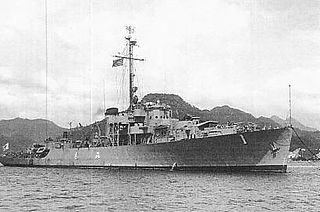
USS Poughkeepsie (PF-26), a Tacoma-class frigate in commission from 1944 to 1945, was the first ship of the United States Navy to be named for Poughkeepsie, New York. She later served in the Soviet Navy as EK-27 and in the Japan Maritime Self-Defense Force as JDS Momi (PF-4), JDS Momi (PF-284), and as YAC-13.

USS Pasco (PG-114/PF-6), a Tacoma-class patrol frigate in commission from 1944 to 1945, has thus far been the only ship of the United States Navy to be named for Pasco, Washington. She later served in the Soviet Navy as EK-12 and in the Japan Maritime Self-Defense Force as JDS Kashi (PF-3/PF-283) and as YAC-12.

USS Charlottesville (PF-25), a United States Navy Tacoma-class frigate in commission from 1944 to 1945, has been the only US Navy ship thus far to be named for Charlottesville, Virginia. She later served in the Soviet Navy as EK-1 and in the Japan Maritime Self-Defense Force as JDS Matsu (PF-6), JDS Matsu (PF-286) and YAS-36.
USS Newport (PF-27), a Tacoma-class frigate in commission from 1944 to 1945, and from 1950 to 1952, was the second ship of the United States Navy to be named for the city of Newport, Rhode Island. She later served in the Soviet Navy as EK-28 and in the Japan Maritime Self-Defense Force as JDS Kaede (PF-13), JDS Kaede (PF-293) and as YAC-17.

USS Glendale (PF-36), a Tacoma-class patrol frigate, is the only ship of the United States Navy to be named for Glendale, California. In commission in the US Navy from 1943 to 1945, and from 1950 to 1951, she also served in the Soviet Navy as EK-6 from 1945 to 1949 and in the Royal Thai Navy as Tachin (PF-1) from 1951 to 2000.
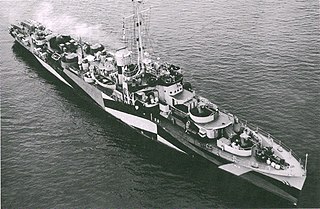
The second USS Gallup (PF-47), a Tacoma-class frigate in commission from 1944 to 1945 and from 1950 to 1951, was the first ship of the United States Navy to be named for Gallup, New Mexico. She also served in the Soviet Navy as EK-22 and in the Royal Thai Navy as HTMS Prasae.

USS Rockford (PF-48), a Tacoma-class frigate in commission from 1944 to 1945, thus far has been the only ship of the United States Navy to be named for Rockford, Illinois. She later served in the Soviet Navy as EK-18 and in the Republic of Korea Navy as ROKS Apnokkang (62).
USS Muskogee (PF-49), a Tacoma-class frigate in commission from 1944 to 1945, thus far has been the only ship of the United States Navy to be named for Muskogee, Oklahoma. She later served in the Soviet Navy as EK-19 and in the Republic of Korea Navy as ROKS Dumon (PF-61).
USS Adopt (AMc-114/AM-137/MSF-137) was an Admirable-class minesweeper built for the United States Navy during World War II and in commission from 1943 to 1945. In 1945, she was transferred to the Soviet Navy under Lend-Lease as T-332.
USS Bombard (AM-151) was an Admirable-class minesweeper built for the United States Navy during World War II and in commission from 1944 to 1945. In 1945, she was transferred to the Soviet Union, serving after that in the Soviet Navy as T-336.
USS Bond (AM-152) was an Admirable-class minesweeper built for the United States Navy during World War II and in commission from 1943 to 1945. In 1945, she was transferred to the Soviet Union and served after that in the Soviet Navy as T-285 and as BRN-37.
USS Astute (AM-148) was an Admirable-class minesweeper built for the United States Navy during World War II and in commission from 1944 to 1945. In 1945, she was transferred to the Soviet Navy, in which she served as T-333.
USS Indicative (AM-250) was an Admirable-class minesweeper built for the United States Navy during World War II and in commission from 1944 to 1945. In 1945, she was transferred to the Soviet Union and served in the Soviet Navy as T-273. The Soviets converted her into a naval trawler in 1948 and renamed her Tsiklon.
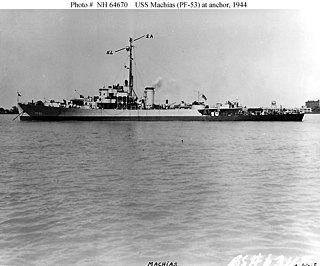
The second USS Machias (PF-53) was a United States Navy Tacoma-class frigate in commission from 1944 to 1945 which later served in the Soviet Navy as EK-4 and the Japan Maritime Self-Defense Force as JDS Nara (PF-2), JDS Nara (PF-282) and YTE-8.
The second USS Bath (PF-55) was a United States Navy Tacoma-class frigate in commission from 1944 to 1945 which later served in the Soviet Navy as EK-29 and the Japanese Maritime Self-Defense Force, with her Japanese name reported by various sources as JDS Maki (PF-18) and JDS Maki (PF-298), and later as YTE-9.

Project Hula was a program during World War II in which the United States transferred naval vessels to the Soviet Union in anticipation of the Soviets eventually joining the war against Japan, specifically in preparation for planned Soviet invasions of southern Sakhalin and the Kuril islands. Based at Cold Bay in the Territory of Alaska, the project was active during the spring and summer of 1945. It was the largest and most ambitious transfer program of World War II.
